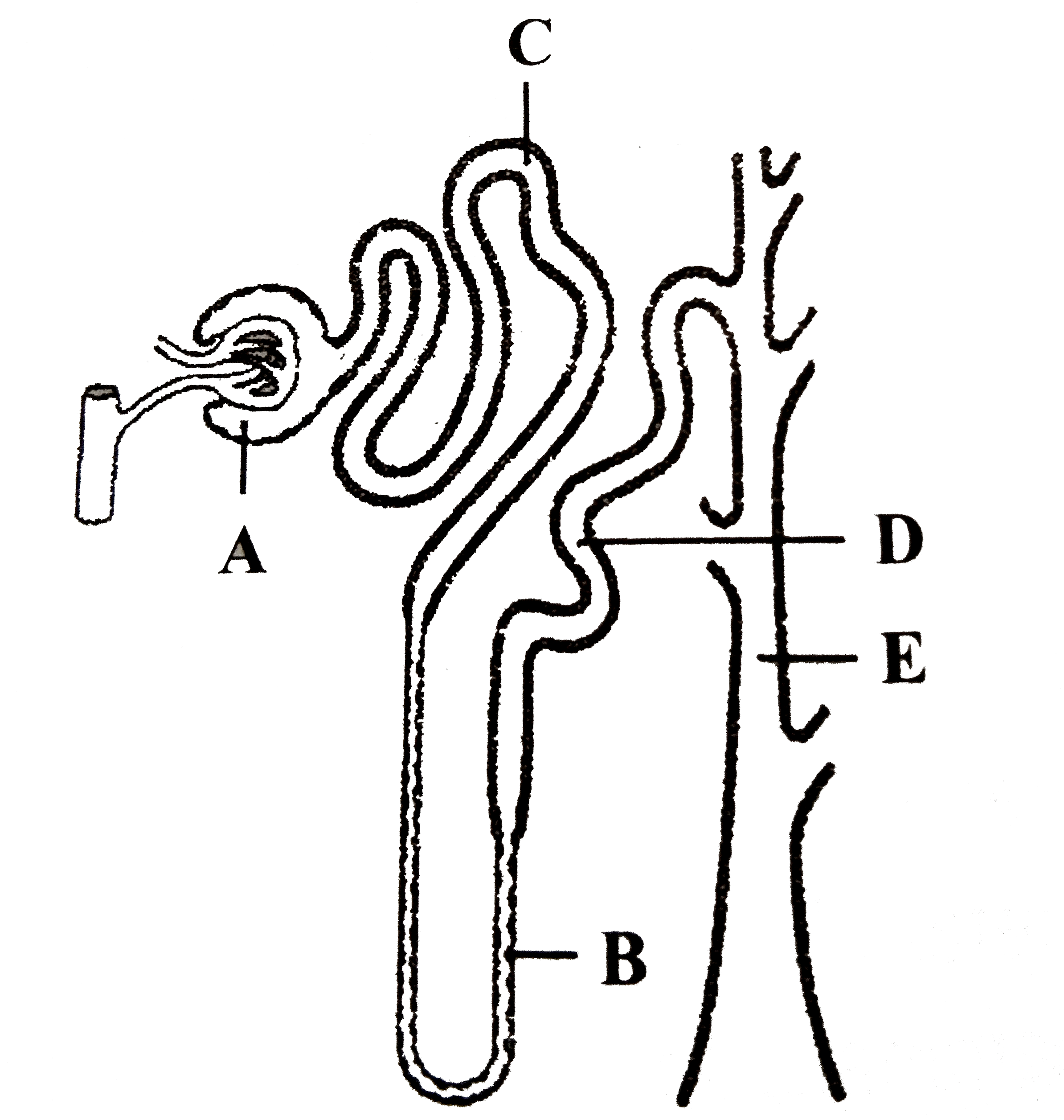A: The final reabsorption of water from urine into blood ocurs through the collecting duct of a mammalian nephron, resulting in the production of hyperosomotic urine.
R: The loop of Henle is responsible for the formation of a sodium gradient across the depth of the medullary intersitium of a mammalian kidney.
If both Assertion & Reason are true and the reason is the correct explanation of the assertin, then mark (1)
If both Assertion & Reason are true but the reason is not the correct explanation of the assertin, then mark (2)
If Assertion is true statement but Reason is false, then mark (3)
If both Assertin and Reason are false statements, then mark (4)
The correct Answer is:B
Step-by-Step Solution:
1. Understanding the Assertion: The assertion states that the final reabsorption of water from urine into blood occurs through the collecting duct of a mammalian nephron, resulting in the production of hyperosmotic urine.
- The collecting duct is indeed responsible for the reabsorption of water, which is regulated by the hormone ADH (antidiuretic hormone). When ADH is present, the collecting duct becomes more permeable to water, allowing more water to be reabsorbed back into the bloodstream.
2. Understanding the Reason: The reason states that the loop of Henle is responsible for the formation of a sodium gradient across the depth of the medullary interstitium of a mammalian kidney.
- The loop of Henle consists of a descending limb and an ascending limb. The descending limb is permeable to water but not to sodium, leading to water being reabsorbed and concentrating the urine. The ascending limb, on the other hand, is impermeable to water but actively transports sodium ions out into the medullary interstitium, creating a sodium gradient.
3. Connecting the Assertion and Reason: The assertion and reason are connected because the sodium gradient established by the loop of Henle is crucial for the collecting duct to reabsorb water effectively. The higher osmolarity in the medullary interstitium allows water to be drawn out of the collecting duct, leading to hyperosmotic urine.
4. Conclusion: Both the assertion and reason are true, and the reason correctly explains the assertion. Therefore, the correct answer is that both the assertion and reason are true, and the reason is a correct explanation of the assertion.
Final Answer:
Both the assertion and reason are true, and the reason is a correct explanation of the assertion.
---
- The collecting duct is indeed responsible for the reabsorption of water, which is regulated by the hormone ADH (antidiuretic hormone). When ADH is present, the collecting duct becomes more permeable to water, allowing more water to be reabsorbed back into the bloodstream.
- The loop of Henle consists of a descending limb and an ascending limb. The descending limb is permeable to water but not to sodium, leading to water being reabsorbed and concentrating the urine. The ascending limb, on the other hand, is impermeable to water but actively transports sodium ions out into the medullary interstitium, creating a sodium gradient.
Both the assertion and reason are true, and the reason is a correct explanation of the assertion.
Topper's Solved these Questions
- EXCRETORY PRODUCTS AND THEIR ELIMINATIONBOOK - AAKASH INSTITUTE ENGLISHCHAPTER - EXCRETORY PRODUCTS AND THEIR ELIMINATIONEXERCISE - SECTION C (PREVIOUS YEARS QUESTIONS)
46 Videos
- EVOLUTIONBOOK - AAKASH INSTITUTE ENGLISHCHAPTER - EVOLUTIONEXERCISE - TRY YOURSELF
29 Videos
- HUMAN REPRODUCTIONBOOK - AAKASH INSTITUTE ENGLISHCHAPTER - HUMAN REPRODUCTIONEXERCISE - Try Yourself
19 Videos
Similar Questions
Which of the following statements about the functioning of the kidney is CORRECT ?
I. On a average , 1100-1200 ml of blood is filtered by the kidneys per minute which constitute roughly 1/5th of the blood pumped out by both the Ventricles of the heart in a minute .
II. JGA is a special sensitive region formed by cellular modifications in the distal convoluted tubule and glomerulus at the location of their contact .
III. The ascending limb of Henle's loop is impermeable to water but allows transport of electrolytes.
IV. The collecting duct allows passage of small amounts of urea into the medullary interstitium to keep up the osmolality.
View SolutionWhich feature enables the mammalian kidney to concentrate urine in the medullary region?
(a) Rapid removal of sodium ions from medullary tissues.
(b) Maintaining a high osmotic pressure in the tissues between the tubules.
(c) High oxidative metabolism of medullary cells.
(d) Rapid flow of blood through the medulla.
View Solution
Knowledge Check
Statement-1: The final reabsorption of water from the urine into the blood occurs through the collecting duct of a mammalian nephron resulting in thhe production of hyperosmotic urine.
Statement-2: The loop of henle creates a sodium gradient in the interstitial fluid.Aboth statements 1 and 2 are correct.BStatement 1 is correct but statement 2 is incorrectCStatement 1 is incorrect but statement 2 is correctDBoth statements 1 and 2 are incorrect.
The given figure represents a single nephron from a mammalian kidney. Identify the labelled parts, match them with the functions (i-iv) and select the correct option.
(i). The site of ultrafiltration.
(ii). Particularly sensitive to ADH.
(iii). The main site for the reabsorption of glucose and amino acids.
(iv). Largely responsible for the maintenance of blood pH.Aa) (i)-A,(ii),E,(iii)-C,(iv)-DBb) (i)-A,(ii)-B,(iii)-C,(iv)-DCc) (i)-B,(ii)-A,(iii)-C,(iv)-EDd) (i)-E,(ii)-B,(iii)-D,(iv)-AMatch column I with column II and select the correct option form the codes given below.
Column IColumn IIA. Delivers blood to glomerulus(i). Ascending and descending limbsB. Carries urine to pelvis(ii). Renal arteryC. Collects filtrate from Bowman's capsule(iii). Collecting ductD. Loop of Henle(iv). PCTAA-(ii),B-(iii),C-(iv),D-(i)BA-(i),B-(iii),C-(ii),D-(iv)CA-(ii),B-(iv),C-(i),D-(iii)DA-(iv),B-(iii),C-(ii),D-(i)
